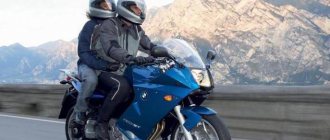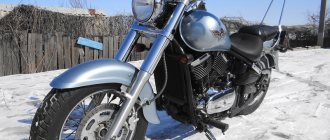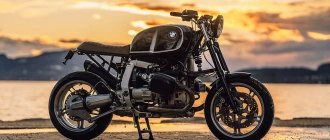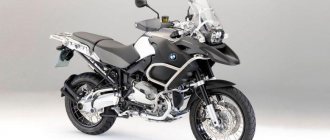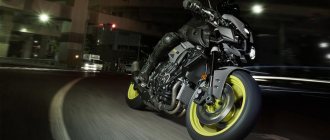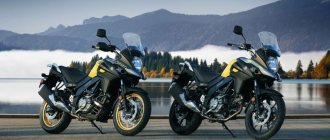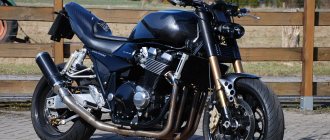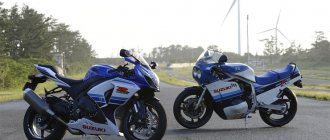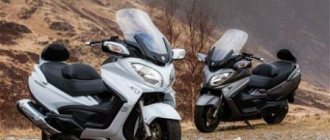RU-MOTO rating
- Reliability
- Chassis
- Appearance
- Comfort
- Price
4.6
Verdict
Suzuki GSR 600 is an excellent choice for daily use: relatively budget-friendly; comfortable driving position; eats fuel moderately; inexpensive to operate; bright appearance.
Just a few years ago, almost every street racer dreamed of buying a Suzuki GSR 600. This long-awaited bestseller from the Japanese automobile concern was released in 2006 as a counterweight to motorcycle models from competitors from Honda, Kawasaki and Yamaha. What captivated the hearts of thousands of bikers with this model? This is what she looks like in the photo:
External view of the Suzuki GSR 600 motorcycle
Read on about its features and characteristics.
Model description
Suzuki GSR 600 2006 is a high-tech motorcycle model with a sporty bent. It was produced until 2011, giving way to the GSR 750. Its features:
- modified injection engine from the GSX-R 600 sports model with an electronic fuel injection system;
- new instrument panel with an informative LCD screen;
- reinforced cast aluminum frame;
- powerful brakes with 4 pistons and ABC;
- possibility of rear suspension adjustment;
- bright aggressive design.
The developers paid due attention to ergonomics. The shape of the saddle provides a comfortable, loose fit for both driver and passenger. The motorcyclist does not need to reach up to the handlebars, and when stopping, it is easy to touch the ground with his foot. The special shape of the tank allows the driver to comfortably wrap his legs around it during turns and braking.
Read other motorcycle reviews of the Honda CBR600RR: technical specifications, prices and reviews
Technical features of the Suzuki GSR 600
Review of the Suzuki GSR 600 motorcycle
The motor on the Jaeser is from the gsx-r 600, for those who don’t know, this is a sport bike, a very good bike with an excellent engine. So the engine on it is from this sports bike, although of course it’s derated for the sake of torque (and that’s good). In the city the engine does not jerk, does not get particularly hot, runs calmly and accelerates even from 3-4 gears, from the very bottom. This is not the case on a sports bike. Although, to be honest, this GSR really wakes up after 9-10 thousand, so to speak, the super-sport genetics come to light! And then he vacuums very well. Its engine is not as calm as it might seem at the beginning of the ride; it also has a pick-up in the middle of the revolutions, but it is still quite predictable.
Otherwise, traction is smooth and predictable throughout the entire rev range.
We drove 100 km along the highway with the same GSX-R 600, so I didn’t feel inferior on the GSR, I can handle 200 and 220 if necessary, although the wind protection is certainly not the same! not very comfortable at speeds over 160.
Well, this is not a super sport, but a naked bike, a bike for the city! )
The exhaust is very interesting, you can compare it to an insect. When you drive slowly, around the city, you are practically inaudible... calm)) but as soon as you crank it up to 5-7 thousand, the sound begins to really catch you with its “madness”; there’s no other word for it.. =)
Finally, I can say: of all the motos that I had, the best memories remain about this one, as the most convenient and practical! If you have doubts about choosing the GSR 600 or anything else, I advise you to choose it, this choice will definitely please you! 
I also ride a GSR 600, an excellent bike for all occasions. I've been using it for 50 thousand km, not new, I'm the third owner, and for some reason I don't really want to change it to a fresher one. A liter is needed for the highway, but 600k in the city is a steal, and when I drive on the highway, I mostly overtake all the cars. In general, to each his own, I’m quite happy with this bike. Smooth roads everyone!
Third season on the GSR 600 steering wheel, very pleased with the equipment, not a single breakdown, only maintenance. I have a car, in the summer the car sits in good weather, it’s a pleasure to avoid traffic jams on a motorcycle, and in the evenings you can twist the throttle.
I have GSR. Excellent device. But! Like any technique, it requires attention: customization (handles, levers, etc.). For a “post-Chinese” person, I sat down normally. Mot is evil. Don't expect it to be smooth. If you haven’t had any survival practice in Moscow, even at least on a scooter, I recommend extending the courses through early morning trips and late evening trips. Among the advantages: motor, which is always enough, mega reliability. Disadvantages: the center is a bit high, the box is noisy.
GSR 600 Great bike! I bought one for myself as my first one. There is no ABS, which I regret very much (I blocked the front end once and almost fell apart). If you turn it up to 8 it’s quite calm, after 10 it’s a plague. I opened the second season on it and have no plans to change it yet.
Tuning
Buying a stock motorcycle necessarily means customizing it to suit the driver’s parameters. This increases safety and improves handling and ride quality. Common tuning options:
- installation of protective arches on the engine;
Protection bars on the Suzuki GSR 600 engine
- replacing the stock exhaust (weight 5 kg) with a lighter one;
- replacing brakes with more reliable ones, with a “floating” disc;
- replacing the engine cover with a chrome one;
- replacing shift knobs with shorter ones;
Tuning shift knobs for Suzuki GSR 600
Read other motorcycle reviews Kawasaki ER-6N motorcycle review
- Replacing the stock driver and passenger footrests with lightweight ones.
The main thing in tuning is not to overdo it, and to use a simple axiom: “A racing car is built around the driver.” After all, a bike is created for the biker, and not vice versa.
Breakdowns and malfunctions
There are several main technological faults:
- absence of a retaining ring on the oil seal of the cooling system pump. After a certain period of operation, the oil pushes the oil seal out and a severe leak occurs;
- accelerated wear of the steering column bearings due to the presence of “technological” holes in the frame:
Major technological malfunctions of the Suzuki GSR 600
The accumulation of dust and dirt in these holes damages the bearings, causing play in the steering wheel. To fix the problem, you just need to seal these holes;
- when driving at low speeds, jerks in the fuel injection system appear;
- Driving at high speeds on the motorway causes steering vibration, which impairs visibility through the side mirrors.
The pluses include the durability of the clutch cable for the Suzuki GSR 60, which distinguishes this model from most competitors.
Suzuki GSR 600: Comparative test drive with Yamaha FZ6N
Undressing your models (and not just motorcycles) has now become almost a rule of good manners. In the lineup of almost all manufacturers there will definitely be some kind of nudist, and more than one... The idea of this test crystallized as soon as we managed to “skate” the newest Suzuki GSR600 in Sardinia (“Motoreview”, No. 2/2006). a more suitable opponent than the Yamaha FZ6N . Even the design of these models has many similarities. First of all, I wanted to compare my feelings received during the test in Italy in a calmer and more measured environment at home, without being surrounded by a crowd of raging test pilots with clearly expressed suicidal tendencies.
Even in distant Sardinia, during the first test, it seemed to me that Suzuki were somewhat overzealous with trimming the horsepower of the engine of one of the best sport bikes at the moment, the Suzuki GSX-R 600 . Of course, a city “naked” motorcycle probably does not need the explosive character of a sportbike, twisted to the very tomatoes. But as a result, the character of the newest “Sousa” GSR, from my point of view, turned out to be somewhat amorphous in places.
All attempts to imagine myself as a 40-kilogram Japanese - a Suzuki , who, under severe torture in Italy, admitted to me that he managed to accelerate a naked bike to 240 km/h - alas, did not bring results. The most I managed to squeeze out of the digital speedometer was 230 km/h, which, in general, you’ll agree, is also not bad at all. Especially if you take into account such an important fact that it is simply physically impossible to exist at this speed for more than a minute. The head begins to shake, like someone who has been fighting a green serpent for decades. It is interesting to note that our employee Nikolai Bogomolov, moving in parallel courses with me on a Yamaha FZ6N, did not at all look like a Gold Wing owner who had fallen into nirvana, casually sipping beer at a speed of about 200 km/h due to almost absolute wind protection. So in this nomination, both motorcycles... lost, once again proving that for exercises at speeds over 200 there are much more suitable devices.
But if you quickly change from one motorcycle to another, then in the very first minutes of riding a Suzuki you just want to shout: “Robbed!” If on Yamaha, when reaching 10,000 rpm, there is a noticeable acceleration, not to say, of course, that such a sportbike kick, but still... then with the GSR, at these speeds, things are progressing much less joyfully...
Although in absolute terms our opponents drive almost identically, the difference can only be detected with precision instruments. And it is unlikely that it will go beyond one second, say, at a distance of 400 meters. At the same time, I do not at all presume to say that Yamaha will be the undisputed winner. However, on a subjective level, all this is perceived somewhat differently. When accelerating, “Three Tuning Forks” gives a pleasant surge of adrenaline. The engine tuning is much closer to the original source, that is, the Yamaha YZF-R6 . While on Suzuki it is no longer necessary to act in a sportbike manner, but rather in a road manner. If you crank the engine up to three-digit values, you are unlikely to get the expected acceleration. More appropriate, oddly enough, would be the tactics characteristic of liter engines: hang a little in one gear - and, without stopping, push the next one, a solid moment will do its job and pull it out.
If all this is presented in a mandatory program called “While the editor-in-chief does not see,” then the situation turns out to be as follows. On a Yamaha, it’s enough to “spit” the clutch in second gear, after making sure that the tachometer needle “lives” at 10,000 rpm and above, and you can already enjoy the wheelie. This trick doesn't work on Suzuki Having pretty much tormented the slightly withered relative of the Suzuki GSX-R600 , I finally made it roll in second gear on the rear wheel. But how difficult this exercise turned out to be for him! Yes, decent traction has not disappeared anywhere, but it “hangs out” in a narrow corridor of 7000–9000 rpm, which you must definitely “get into.” I want to emphasize that we are talking exclusively about driving on the rear wheel. In the conditions of ordinary city traffic, the difference primarily lies in the fact that in order to move dynamically, the Yamaha FZ6N will need to be cranked into space in every gear, while the Suzuki requires much less frequent use of the gear shift lever. Our students also differ in the pilot’s landing position, and this already leads to a different perception of the machines, both in general and in purely individual views. It seems that in both cases the seat is at the same low height from the ground (although on the Suzuki it is still a little lower), and the steering wheel in both is straight. It would seem, what difference can we talk about? But the GSR has a slight emphasis on sport, with the rider positioned a little more forward and the distance to the rider's footpegs being shorter than on the Yamaha . Initially, such a landing sets one up for a more aggressive driving style, but the calm nature of the engine ultimately comes into dissonance with the pilot’s mood.
On the Yamaha FZ6N the situation is reflected in a slightly different way. Here the landing is frankly relaxing - completely straight, without the slightest strain on all the limbs of the body. The picture of complete relaxation is completed by the driver's footrests, installed through damping rubber spacers; as a result, this option completely “detaches” the pilot from engine vibrations at any speed. But the character of the engine with a nervous tic - a kick at high speeds - immediately takes you out of the resort state. I would like to take a more sporty position, but the high steering wheel does not go well with such moods.
And further. Both motorcycles do not shine with the volume of underseat space, which is a noticeable disadvantage for city dwellers. But what is better on the Suza is the visibility in the mirrors and the dashboard, which migrated here from the Suzuki GSX-R600 almost unchanged...
As for the braking potential, both models deserved a solid four, and I was not able to identify a clear leader; the characteristics are very similar, without obvious punctures or shortcomings.
Taking a specially trained girl with me - a kind of indicator of the convenience of boarding a passenger - we took a ride at maximum speeds on both the GSR and the Yamaha FZ6N (and the latter also in a wheelie). Her verdict was clear: the Yamaha is much more comfortable for a passenger in almost every aspect. Of course, this does not mean that a passenger on a Suza will feel like a poor relative from Kursk at a wedding of rich Moscow relatives; it is more appropriate to compare him with a resident of St. Petersburg, lost in the Moscow metro... When all the nuances of both ergonomics and behavior of motorcycles in the city and on the highway became obvious, all that remains is to check to what extent the designers managed to stifle the sporting component of their ancestors, the sportbikes. The complex turns of a karting track are ideal for this.
And yet, no matter how much Yamaha preened and painted itself, it became very difficult for it Suzuki Both models cannot please you with the richness of adjustments of conventional front telescopes, but to complete this budget picture, the Yamaha FZ6N has a rear pendulum with a huge luminous inscription: “They openly saved money on me!” But on the Suza, the rear swingarm is in perfect order - its complex shape and rigidity could be the envy of other sports bikes. Subsequent promenades in attempts to keep up the pace of the “people” training here on sportbikes completely revived Suzuki . With a certain detachment and... how to put it mildly... well, let's say, recklessness, the GSR quite manages to maintain the pace of some decent "six hundred" (I won't throw around names here, because this is by no means a matter of problems of any particular brand...). It is also important to note that the company remained true to its principles - to focus motorcycles on the track, even in such a civilian variation as the GSR. This is expressed primarily by the fact that if you first unscrew the footpeg stops, then even with the strongest tilts the motorcycle does not come into contact with the asphalt. The same cannot be said about the Yamaha FZ6N , which in vain erases the side stand on the asphalt at decent angles! And although its suspension seemed to me even a little tighter and more “collected” than on my opponent, on the karting track I still couldn’t maintain the pace of the GSR; I felt some disconnection and distancing of the motorcycle from the pilot. I think the “axe-chopped” rear swingarm played a significant role in this behavior of Yamaha.
In order not to impose my very, very biased opinion on a readership of many thousands, this time I decided to give the floor to another of our employees and an active participant in this comparison. The funny thing is that Nikolai Bogomolov is, by all accounts, a polarizing person for me. So, this is how these motorcycles were seen by a militant adept of cross-country machines, whom I have recently been trying to return to the fold of the asphalt religion. I give him my word...
“What can you buy for $10,000? This is exactly the question that is currently perplexing your humble servant, who is choosing a “road car” for all occasions. The options that emerge are not the most promising. A three-year-old “liter”, repeatedly raped by the previous owner in a perverted form, a new enduro or motard not of the highest class... The only ray of light in the dark kingdom is the Yamaha FZ6 , a road “six hundred”, available in two versions, S (with a semi-fairing) and N ( naked). In terms of price/performance ratio, it is one of the best options in its class today.
Most “budget” motorcycles have one unpleasant feature: designers try to achieve low prices by saving on fairly important parts. As a result, the owner of a “canary for a penny” discovers that the engine power cannot be used due to the flimsy chassis and weak brakes, and the plastic looks like it was painted with a brush at an Armenian car service center. On the Yamaha FZ6, it was not possible to find any traces of economy during a superficial inspection. Everything is mature: aluminum frame, powerful brakes, fuel injector, decent appearance. The only thing I can complain about is the telescopic fork. However, a good “telescope” is not always inferior in characteristics to a “shifter”. I spent the weekend before the test alternately logging hundreds of kilometers on a chopper, sportbike, and cross-country motorcycle on roads and off-roads of varying quality. As a result, my arms, legs, back and butt ached mercilessly, and the thought of having to drive again caused deep depression. But landing on the Yamaha FZ6 was surprisingly humane. A soft, wide seat, a natural driver's position without extreme bends forward or backward, in a word, you drive and relax.
The dashboard was a little let down. In the bright sun, burning light bulbs, to put it mildly, are not noticeable. The tachometer, made in the form of a liquid crystal track running in a circle, is also not particularly easy to read, especially during intense acceleration. But the information content of the “tidy” is outstanding: if you strain your eyes, you can see a lot of useful data - from the fuel level to the current time. In traffic jams the motorcycle is nothing outstanding. Medium width, steering grips cling to the mirrors of small cars. The mirrors stick out to the sides, so with one of them, without even noticing it, I tore off the side of a standing bus. The engine is also not conducive to slow driving. At low speeds the motorcycle moves mediocrely. Although the manufacturer claims that the engine is from a Yamaha R6 (YZF-R6)
installed on
the Yamaha FZ6 , about 20 forces were deprived specifically to equalize traction, the “bottoms” are far from ideal.
After sluggishly driving through traffic jams, I finally noticed an open path ahead and sharply opened the gas in second gear. The tachometer instantly approached the 8000 mark, the front wheel left the ground, and the motorcycle shot forward so much that I had to resort to emergency braking so as not to find myself lying in the trunk of the car ahead. After that I never slowed down. True, I had to work with my left leg and left hand and forget about the mirrors, which had lost all usefulness due to vibrations. But the pleasure of riding a heart-rending screaming projectile between cars darting to the sides compensated for all the inconveniences. Or rather, almost everything: the motorcycle easily accelerates to 225 km/h, while still having a considerable reserve left. How big it is, only a man with an iron neck can find out. I’m not one of those people, so after “two hundred” I began to seriously worry that my head, along with the helmet, would fall into my pants under the pressure of the air flow. So for anyone who doesn't intend to comply with current speed limits, I would recommend purchasing the half-fairing version.
But the suspension of the Yamaha FZ6 is not sportbike. And this is more good than bad for driving on public roads. On uneven surfaces, the steering wheel does not begin to shake in your hands, like a virgin in the arms of a lustful classmate, and the seat does not throw your “fifth point” above your head. At the same time, the handling for city driving is through the roof. And Zdorov managed to perform well at the karting track. For several laps he hung on the tail of fairly well-known circuit athletes, reaching the asphalt with his slider in turns. True, at the same time, the side stand scraped along the road surface, and the pilot himself demonstrated a stretch worthy of Alina Kabaeva.
With all this, the motorcycle forgives many mistakes. Having gone to the same karting track for the first time in his life, your humble servant performed the tricks of “drifting the rear wheel at the entrance to the turn”, “late braking with access to the ground” and “tilted wheelie”. Zdorov, his face changing, said that on a sportbike I would have been catapulted into the gravel three times already. These situations did not cause me much discomfort.
On paper, the characteristics of the Yamaha FZ6 and GSR are strikingly similar, although the Susa costs about $1,500 more. So I also considered it as one of the purchase options. All that remained was to find out where the difference in price came from.
The futuristic design of the GSR catches the eye from afar. The Yamaha FZ6 cannot be called a freak, but the Suzuki , with turn signals mounted in plastic, round brake lights between the exhaust pipes and a powerful swingarm, looks much better. The dashboard is a little richer: it even has a gear indicator. The instruments are easier to read than on the Yamaha, especially the dial tachometer.
Low end is clearly better in the GSR thanks to the clever traction control system. But in general, the engine, despite exactly the same declared power, clearly loses in dynamics. The maximum speed, as on the Yamaha FZ6 , could not be measured for the same reasons. And it won’t succeed: there are no “plastic” versions of the GSR in sight. True, a host of tuning firms already offer several options for a small embryonic windshield, but still this is not a full-fledged answer to the factory version of Fazer, elegantly dressed in a respectable half-fairing.
Otherwise, motorcycles are twin brothers. Equally comfortable fit, similar handling, identical, despite the slightly smaller size of the front discs on the Yamaha, and identical brakes. Even the front lights are similar. One question remains: is it worth paying 15% more for flashy looks and a dull engine?
Go to the Suzuki GSR 600
- Read review of Suzuki GSR 600
Check out the test drives:
- Suzuki GSR600: Test drive from Bike magazine
Main competitors
- Honda Hornet
third generation (2007 – 2012).
Characteristics:
- maximum speed: 225 km/h;
- fuel consumption: 5.8 l / 100 km;
- acceleration from 0 to 100 km/h: 3.3 s;
- weight: 172 / 202 kg – dry / equipped;
- price: from $2300 (2007), to $7000 (2012).
The number one competitor has a 15 km/h lower maximum speed, 0.8 liters higher consumption, and an order of magnitude more expensive than the prices of models from recent years of production.
- Yamaha FZ6
(2004 - 2009 release).
Characteristics:
- speed maximum: 219 km/h;
- fuel consumption: 6.4 l / 100 km;
- acceleration from 0 to 100 km/h: 3.8 s;
- weight: 185 / 209 kg – dry / equipped;
- price: from $3500 (2004), to $6500 (2009).
Competitor number two has a 21 km/h lower maximum speed, 1.4 liters more fuel consumption, and a significantly higher price than Suzuki models of the same year.
- Kawasaki Z750
second generation (2007 – 2012 release).
Characteristics:
- top speed: 230 km/h;
- fuel consumption: 6.5 l / 100 km;
- acceleration from 0 to 100 km/h: 3.8 s;
- weight: 203 / 222 kg – dry / equipped;
- price: from $2200 (2007), to $6500 (2012).
Competitor number three has a 10 km/h lower maximum speed, 1.5 liters more consumption, and a higher price for similar models.
So, the Suzuki GSR 600 is the fastest (maximum speed – 240 km/h), in terms of acceleration from 0 to 100 km/h it is inferior to the Honda Hornet by 0.1, beats competitors in price, and is the most economical in fuel consumption.
Spare parts for the GSR 600 cost approximately the same as those of the listed competitors. You can save money by ordering cheaper, non-original spare parts.
Hello everyone. So I got around to remembering and writing about how I came to buy my first motorcycle. It all started with a relative’s advice towards American auctions. After studying this topic a little, reading reviews and the experience of such a purchase, I came to the conclusion that all this is extremely hemorrhagic for the first inexpensive bike, and also smacks of a pig in a poke. Therefore, I rejected this option. Next, I decided to study the issue of Japanese auctions (which was much closer to my heart), but after 2-3 nights of monitoring options on 2 sites (I don’t remember the names, I chose them based on recommendations from the pro japan video), I still could not find a profitable option, which, after shipping, customs and maintenance, would go to my budget, which I set at 300-350 thousand wooden ones. As a result, the auctions were canceled.
Here I will make a digression that I did not choose something specific, but looked at what I could buy in my budget and the newer the better, preferably 2013 and newer. But after auctions were no longer required, I tried to make my requests more specific. There were many opinions: some said that we should take 300 cubes, roll a season, sell, take 600, roll a season, sell, take a liter. Others said that this is a perversion and take a liter right away and get used to it. A relative generally recommended a Cruiser like a Kavas Vulcan with 1.5-2 liters.
I, driven by the desire to learn how to ride and ride for a long time, and not disintegrate in the first season on a motorcycle for which I am not ready, went to the Yamaha officials to look at the mt-03. Yes, it’s a good motorcycle, the plus is that it’s new or in my budget it was 2-3 years old, not a secondary one. I sat on it, took a photo - well, a bear on a scooter, it doesn’t fit my dimensions. Then I went and looked at the Honda NC750X - yes, it was a completely different level, I really liked the bike, and considering that there was nothing to compare it with, I could say I fell for it. But the condition was not ideal, and the seller did not want to change the price at all. After that, I found the same Honda in the advertisements but 750NA (a more street version). The price was 60k cheaper, the year was the same, the mileage indicated was 5000 or so. I watched it and liked it. And I decided to check the history of the motorcycle - and then a surprise awaited me... It was imported 2+ years ago and already had a service mileage of 30,000. After such a frank p... from the seller about the original mileage, he lost the desire to buy something (although he was very was surprised and assured that he had not reeled anything in, maybe before him, etc.). Then I also read reviews that the Enciha’s engine is like a car’s, it spins poorly and you have to shift gears hard, which is not convenient...
Then I clearly decided that I wanted a naked bike, from 70 to 100 hp, from 600 to 750 cc. I started looking for just such options. I immediately decided to look in Moscow and St. Petersburg, but quickly gave up - I didn’t take into account that in Russia bikes are more expensive due to Russian customs, but in Kaliningrad there are many regional ones and hence the price tag is lower. The choice, of course, is meager, but what to do - I continued my search in my region. There were several variants of Sabotage, there was an old Phaser, there was a bandit, there was a gladius. Many dropped out after checking the history. Plus, during the selection process, I watched and read a lot of reviews and eventually came to the conclusion that it was Suzuki that I wanted. You can read about the pitfalls of buying a Suzuki in Kaliningrad in my previous post (How to easily and simply buy a motorcycle in Kaliningrad).
In the end, I settled on 3 options: 1. Suzuki SVF650 Gladius '13 (steel frame, V-shape 2 cylinders, 72 horsepower, 2-piston calipers) 2. Suzuki Bandit GSF600 '13 (steel frame, inline 4 cylinder, 80 horsepower, 2-piston calipers) 3. Suzuki GSR600 '07 (aluminum frame, in-line 4 cylinder, 98 horsepower, 4-piston calipers) All three candidates passed the inspection with dignity and were ready to acquire a new owner in my person.
I was wondering what to choose, since I really wanted a fresher motorcycle, but “let the experts’ stones not fly at me” the GSR is still a level higher than the Gladius (the same SV650 of the mid-2000s) and the Bandit. I liked 4 piston brakes, unlike the old 2 piston ones on Gladius and Bandit, aluminum frame, 4-cylinder engine and exhaust hidden under the saddle, despite the older year of the GSR. In the end, I narrowed down the selection by removing Gladius. In front of me stood a bandit and a GSR - both had problems with registration due to the lack of an engine number in the title (we also read about this in the post “How to easily and simply buy a motorcycle in Kaliningrad”). I puzzled both sellers by saying that I was ready to buy it, but the problem was that I needed a solution to the registration problem. And not one-time, but with inclusion in the PTS. The Bandit seller quietly moved out, and the GSR seller actively began to resolve this issue with me. And after 3-4 days we found a solution and the deal took place.
That's the whole purchase story. I can only say that I don’t regret my choice one bit and I hope that the motorcycle will bring me a lot of positive things from owning it in the future. Something like this =)
Owner reviews
The GSR 600 is a station wagon. It is comfortable and convenient to drive in the city, and on the high-speed track, thanks to its technical data, it will clearly be among the first.
Screenshot No. 2. Reviews from Suzuki GSR 600 owners
Screenshot No. 3. Reviews from Suzuki GSR 600 owners
Screenshot No. 4. Reviews from Suzuki GSR 600 owners
Read other motorcycle reviews Great review of the Stels Enduro 250 motorcycle
